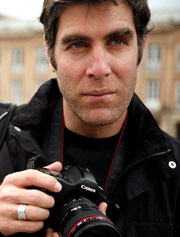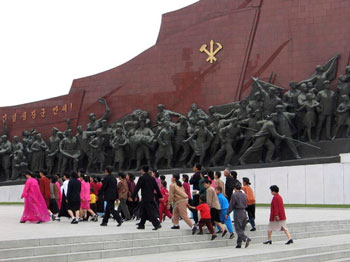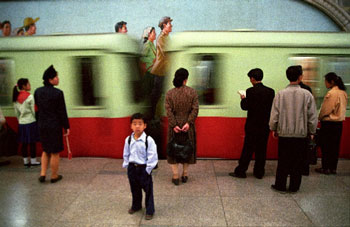 |
North Korea:
The Hermit Kingdom November 2006
|
 |
||||||||||||
|
The most isolated country on the planet, well hidden behind the walls of a totalitarian Stalinist regime based on the total subjugation of its people, is revealed through my photographic documentary that managed to "escape" from censorship. These images are rare since they have managed not to pass through the filtering sieve of the regime. Fugitives, the images provide their own answers to the "major riddle" of Asia and shed some light on this country that now has successfully carried out its first nuclear test and is the focus of publicity.
From the time the Democratic People's Republic of Korea was formed in 1948, the Stalinist-type regime has imposed an authoritarian ideological structure upon the people. The Korean War, the final and most deadly conflict in the Cold War, ended in 1953. The armistice between North and South that followed remains very fragile.
North Korea, the only country of actually existing socialism on the planet today, is a forbidden destination for foreign reporters. It is visited every year by only 1,000 westerners, chosen from different countries. I visited the Democratic People's Republic of Korea two times as a member of a small group of "global" tourists and I stayed in the country for 17 days. On my trip, I had the opportunity to travel in the countryside. I hadn't seen any pictures of this part of the country and I found it very important to document real-life scenes. It took me more than three years to find a way to visit North Korea--all my attempts to get a journalistic visa failed several times.
Almost 80 percent of my pictures were taken in secret using several different methods to avoid the attention of my minders. Frequently acting and feeling like a spy using my camera's self-timer, most of the time I was shooting without looking at the viewfinder, even from inside a bus or a train. I managed to catch the mood of the country and little by little I collected enough material for a story. Every night, I was downloading my pictures in secret to my mp3 player, unbeknownst to my roommate.
From the very first moment I arrived in North Korea I had the strong feeling that I was watching a huge performance and that all the controlled citizens I saw were part of it.
In conclusion, I would say that my story reveals how a country, which recently announced to the world that it has a nuclear arsenal, presents itself to the camera through staged events based on a propaganda scenario using carefully chosen leading performers.
© Yannis Kontos
Dispatches are brought to you by Canon. Send Canon a message of thanks. |
|||||||||||||
Back to November 2006 Contents
|
|



